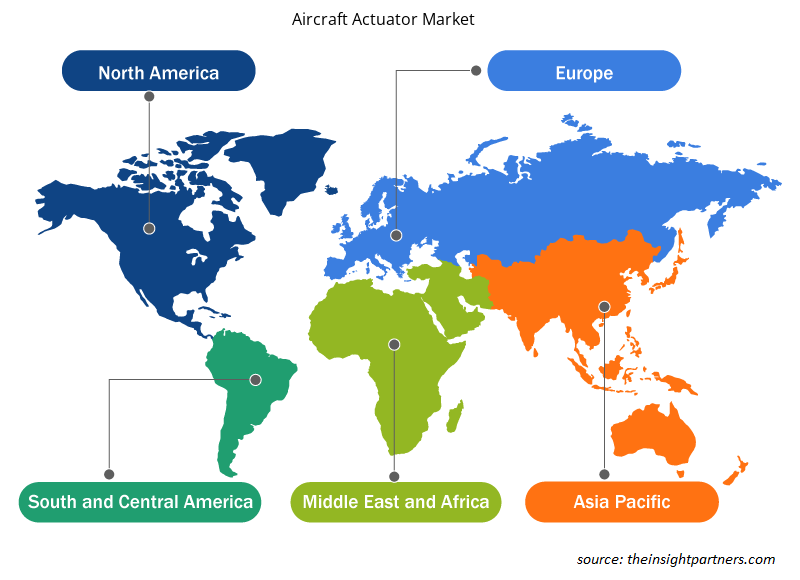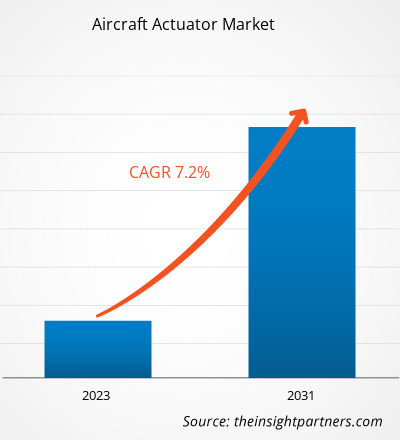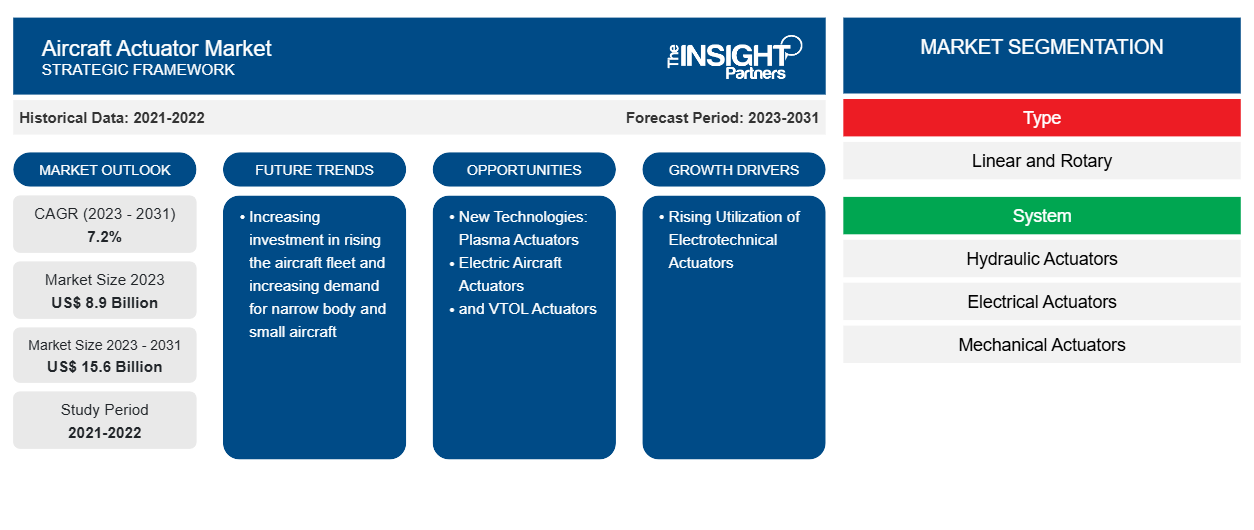Se prevé que el tamaño del mercado de actuadores para aeronaves alcance los 15 600 millones de dólares en 2031, frente a los 8900 millones de dólares en 2023. Se espera que el mercado registre una CAGR del 7,2 % entre 2023 y 2031. El aumento de la inversión en el aumento de la flota de aeronaves y la creciente demanda de aeronaves de fuselaje estrecho y pequeñas se encuentran entre los factores clave que impulsan el mercado de actuadores para aeronaves.CAGR of 7.2% in 2023–2031. Increasing investment in raising the aircraft fleet and increasing demand for narrow-body and small aircraft are among the key factors driving the aircraft actuator market.
Análisis del mercado de actuadores para aeronaves
El crecimiento del mercado de actuadores de aeronaves está impulsado principalmente por importantes inversiones en tecnologías avanzadas en la industria de la aviación. En los últimos veinte años, la industria de la aviación (comercial y militar) ha crecido significativamente. El ritmo de transformación tecnológica ha sido sobresaliente, lo que ha aumentado la demanda de diversos productos y servicios. Existe un aumento en la adopción de soluciones de actuadores de aeronaves en aeronaves comerciales debido al aumento de la demanda de mejoras en los sistemas de control de vuelo y trenes de aterrizaje. El creciente número de accidentes de aviación y la mejora de los estándares regulatorios de seguridad han resaltado la importancia de los actuadores de aeronaves. Para mejorar el nivel de rendimiento, las aeronaves están adoptando sistemas de actuación electromecánicos avanzados. Los actuadores electromecánicos están ganando un crecimiento considerable en el mercado a medida que los fabricantes de aeronaves avanzan hacia la integración de más sistemas eléctricos en las aeronaves. Además, los avances en los sistemas de control de aeronaves, como la digitalización y la conectividad de Internet de las cosas (IoT), están respaldando el crecimiento del mercado.signifacntly. The rate of technological transformation has been outstanding, which has increased the demand for various products and services. There is an increase in the adoption of aircraft actuator solutions in commercial aircraft owing to the rise in demand for improving flight control systems and landing gears. The increasing number of aircraft accidents and improving regulatory standards of safety have highlighted the importance of aircraft actuators. To improve the performance level, aircraft are adopting advanced electromechanical actuation systems. Electromechanical actuators are gaining considerable growth in the market as aircraft manufacturers are moving toward the integration of more electrical systems in aircraft. Further, advancements in aircraft control systems, such as digitalization and IoT) connectivity, are supporting the market growth.
Descripción general del mercado de actuadores para aeronaves
La industria de los actuadores para aeronaves evoluciona continuamente con innovaciones en la oferta de productos para proporcionar sistemas de actuación más pequeños, livianos y rentables. La creciente demanda de actuadores electromecánicos para mejorar los procesos de actuación está impulsando el crecimiento del mercado. La llegada de aeronaves eléctricas está creando una nueva oportunidad para que los actores del mercado se concentren en desarrollar actuadores para aeronaves más livianos, más pequeños y más eficientes. Además, la creciente demanda de flotas de aeronaves pequeñas y de fuselaje estrecho de países en desarrollo y desarrollados impulsa el crecimiento del mercado. El aumento de la electrificación en los sistemas de aeronaves con fórmulas híbridas que utilizan sistemas mecánicos e hidráulicos está impulsando el crecimiento del mercado de actuadores para aeronaves.
Personalice este informe según sus necesidades
Obtendrá personalización en cualquier informe, sin cargo, incluidas partes de este informe o análisis a nivel de país, paquete de datos de Excel, así como también grandes ofertas y descuentos para empresas emergentes y universidades.
-
Obtenga las principales tendencias clave del mercado de este informe.Esta muestra GRATUITA incluirá análisis de datos, desde tendencias del mercado hasta estimaciones y pronósticos.
Factores impulsores y oportunidades del mercado de actuadores para aeronaves
Aumento del uso de actuadores electrotécnicosElectrotechnical Actuators
Los sistemas de control de vuelo de las aeronaves están pasando de sistemas hidráulicos voluminosos, pesados y con fugas a sistemas eléctricos autónomos. Los avances en los actuadores electromecánicos (EM), como la confiabilidad, la naturaleza compacta, el peso ligero y la rentabilidad, están aumentando su adopción en las aeronaves. Las flotas de aeronaves comerciales y militares buscan sistemas avanzados que sean más livianos para mejorar la eficiencia del combustible. Los actuadores en las aeronaves se utilizan en la funcionalidad del tren de aterrizaje , slats y spoilers, asientos, flaps, posicionamiento de álabes guía de entrada del motor, timón, alerones y apertura y cierre de puertas de carga o bahías de armas, entre otros. Dado que los fabricantes de equipos originales de aeronaves están enfatizando cada vez más los modelos de aeronaves livianas, los actuadores electromecánicos están atrayendo a los fabricantes de equipos originales en el escenario actual, lo que está catalizando el mercado de actuadores de aeronaves. Otra razón para la creciente adopción de actuadores electromecánicos es el cambio de paradigma de la industria aeroespacial hacia las aeronaves eléctricas, que está dejando obsoletos los sistemas hidráulicos, neumáticos y mecánicos y está aumentando la adopción de sistemas de actuación eléctrica. Esta tendencia está generando una demanda sustancial de actuadores eléctricos, lo que en última instancia está impulsando el mercado de actuadores de aeronaves.electromechanical (EM) actuators, such as reliability, compact nature, lightweight, and cost-efficiency, are mounting its adoption in aircraft. Commercial and military aircraft fleets are looking for advanced systems that are lighter in weight to enhance fuel efficiency. Actuators in aircraft are used in the functionality of OEMs are increasingly emphasizing lightweight aircraft models, electromechanical actuators are attracting OEMs in the current scenario, which is catalyzing the aircraft actuators market. Another reason for the increasing adoption of electromechanical actuators is the paradigm shift of the aerospace industry toward electric aircraft, which is obsoleting the hydraulic, pneumatic, and mechanical systems and is increasing the adoption of electric actuation systems. This trend is generating substantial demand for electrical actuators, which is ultimately boosting the aircraft actuators market.
Nuevas tecnologías: actuadores de plasma, actuadores eléctricos para aeronaves y actuadores VTOL
La industria de los actuadores de aeronaves ha evolucionado desde los sistemas de actuadores neumáticos y los sistemas de actuadores hidráulicos hasta los sistemas de actuadores eléctricos. A medida que la flota de aeronaves se desplaza hacia fuentes de energía limpia, la adopción de energía eléctrica está en aumento en la industria de la aviación para reducir las emisiones. La llegada de aeronaves eléctricas está creando una nueva tendencia de actuadores eléctricos en el mercado. Por ejemplo, en diciembre de 2020, la empresa Curtiss-Wright recibió el pedido para proporcionar tecnología de actuación de control de vuelo primario para el avión de cercanías totalmente eléctrico de Alice. La empresa ofrece un diseño EMA comercial listo para usar (COTS) que es más liviano, rentable y reduce el riesgo del programa. Además, los sistemas hidráulicos y neumáticos son más voluminosos, lo que aumenta el peso y da como resultado un mayor consumo de combustible. Por lo tanto, la industria aeronáutica está utilizando actuadores eléctricos livianos para reducir el consumo adicional de combustible causado por los sistemas pesados.Curtiss-Wright company received the order to provide primary flight control actuation technology for Alice's all-electric commuter aircraft. The company is offering a commercial-off-the-shelf (COTS) EMA design that is lighter, cost-effective and reduces the program risk. Further, hydraulic and pneumatic systems are bulkier, which increases the weight and results in increased fuel consumption. Hence, the aircraft industry is using lightweight electric actuators to reduce additional fuel consumption caused by heavy systems.
Análisis de segmentación del informe de mercado de actuadores de aeronaves
Los segmentos clave que contribuyeron a la derivación del análisis del mercado de actuadores de aeronaves son el tipo, el sistema y el usuario final.
- Según el tipo, el mercado de actuadores para aeronaves se ha dividido en lineales y rotativos. El segmento lineal tuvo una mayor participación de mercado en 2023.
- Según el sistema, el mercado de actuadores para aeronaves se ha dividido en actuadores hidráulicos, actuadores eléctricos, actuadores mecánicos y actuadores neumáticos. El segmento de actuadores neumáticos tuvo una mayor participación de mercado en 2023.
- En función del usuario final, el mercado se ha segmentado en aviones comerciales y aviones militares. El segmento de aviones comerciales tuvo la mayor participación de mercado en 2023.
Análisis de la cuota de mercado de los actuadores de aeronaves por geografía
El alcance geográfico del informe del mercado de actuadores de aeronaves se divide principalmente en cinco regiones: América del Norte, Europa, Asia Pacífico, Medio Oriente y África, y América del Sur.
En 2023, América del Norte ha dominado el mercado de actuadores para aeronaves. La región de América del Norte incluye a Estados Unidos, Canadá y México. La industria aeroespacial en América del Norte ha madurado debido a la presencia de una gran cantidad de fabricantes de aeronaves, proveedores de tecnología avanzada de actuadores y una fuerza laboral calificada. Existe una enorme demanda de nuevos sistemas de control en la región, ya que los usuarios finales, como los fabricantes de aeronaves militares y comerciales, conocen bien las tecnologías más nuevas. Debido a esto, la adopción de soluciones de actuadores de aeronaves eléctricos e hidráulicos en aeronaves comerciales es alta y se está observando una mayor integración en las nuevas aeronaves de fuselaje estrecho desarrolladas por los fabricantes de aeronaves. El sector aeroespacial comercial en América del Norte está dominado principalmente por Boeing, que también está integrando una amplia gama de actuadores en sus modelos B787 y B777 para un mejor control de vuelo.
Perspectivas regionales del mercado de actuadores de aeronaves
Los analistas de Insight Partners explicaron en detalle las tendencias y los factores regionales que influyen en el mercado de actuadores de aeronaves durante el período de pronóstico. Esta sección también analiza los segmentos y la geografía del mercado de actuadores de aeronaves en América del Norte, Europa, Asia Pacífico, Oriente Medio y África, y América del Sur y Central.

- Obtenga datos regionales específicos para el mercado de actuadores de aeronaves
Alcance del informe de mercado de actuadores de aeronaves
| Atributo del informe | Detalles |
|---|---|
| Tamaño del mercado en 2023 | US$ 8.9 mil millones |
| Tamaño del mercado en 2031 | US$ 15.6 mil millones |
| CAGR global (2023 - 2031) | 7,2% |
| Datos históricos | 2021-2022 |
| Período de pronóstico | 2023-2031 |
| Segmentos cubiertos |
Por tipo
|
| Regiones y países cubiertos |
América del norte
|
| Líderes del mercado y perfiles de empresas clave |
|
Densidad de actores del mercado: comprensión de su impacto en la dinámica empresarial
El mercado de actuadores para aeronaves está creciendo rápidamente, impulsado por la creciente demanda de los usuarios finales debido a factores como la evolución de las preferencias de los consumidores, los avances tecnológicos y una mayor conciencia de los beneficios del producto. A medida que aumenta la demanda, las empresas amplían sus ofertas, innovan para satisfacer las necesidades de los consumidores y aprovechan las tendencias emergentes, lo que impulsa aún más el crecimiento del mercado.
La densidad de actores del mercado se refiere a la distribución de las empresas o firmas que operan dentro de un mercado o industria en particular. Indica cuántos competidores (actores del mercado) están presentes en un espacio de mercado determinado en relación con su tamaño o valor total de mercado.
Las principales empresas que operan en el mercado de actuadores de aeronaves son:
- Aeroespacial Collins
- Corporación Cutiss-Wright
- Corporación Eaton Plc
- Compañía: Honeywell International Inc.
- Meggitt PLC
- Fabricante: Moog Inc.
Descargo de responsabilidad : Las empresas enumeradas anteriormente no están clasificadas en ningún orden particular.

- Obtenga una descripción general de los principales actores clave del mercado de actuadores de aeronaves
Noticias y desarrollos recientes del mercado de actuadores para aeronaves
El mercado de actuadores para aeronaves se evalúa mediante la recopilación de datos cualitativos y cuantitativos posteriores a la investigación primaria y secundaria, que incluye publicaciones corporativas importantes, datos de asociaciones y bases de datos. A continuación, se incluye una lista de los avances en el mercado de actuadores para aeronaves y las estrategias:
- En junio de 2023, Supernal (una empresa de movilidad aérea avanzada) se asoció con UMBRAGROUP. A través de esta asociación, UMBRAGROUP suministrará actuadores y electrónica de control de motores para implementar la arquitectura del sistema para los futuros vehículos de Supernal.
- En julio de 2022, Honeywell International, Inc. firmó un acuerdo con Archer Aviation Inc. A través de este acuerdo, Honeywell suministrará actuadores y tecnología de sistemas climáticos para los aviones de producción de Archer.
Informe sobre el mercado de actuadores de aeronaves: cobertura y resultados
El informe “Tamaño y pronóstico del mercado de actuadores de aeronaves (2021-2031)” proporciona un análisis detallado del mercado que cubre las siguientes áreas:
- Tamaño del mercado y pronóstico a nivel global, regional y de país para todos los segmentos clave del mercado cubiertos bajo el alcance
- Dinámica del mercado, como impulsores, restricciones y oportunidades clave
- Principales tendencias futuras
- Análisis detallado de las cinco fuerzas de Porter
- Análisis del mercado global y regional que cubre las tendencias clave del mercado, los principales actores, las regulaciones y los desarrollos recientes del mercado.
- Análisis del panorama de la industria y de la competencia que abarca la concentración del mercado, el análisis de mapas de calor, los actores destacados y los desarrollos recientes
- Perfiles de empresas detallados con análisis FODA
- Análisis histórico (2 años), año base, pronóstico (7 años) con CAGR
- Análisis PEST y FODA
- Tamaño del mercado, valor/volumen: global, regional y nacional
- Industria y panorama competitivo
- Conjunto de datos de Excel
Informes recientes
Testimonios
Razón para comprar
- Toma de decisiones informada
- Comprensión de la dinámica del mercado
- Análisis competitivo
- Información sobre clientes
- Pronósticos del mercado
- Mitigación de riesgos
- Planificación estratégica
- Justificación de la inversión
- Identificación de mercados emergentes
- Mejora de las estrategias de marketing
- Impulso de la eficiencia operativa
- Alineación con las tendencias regulatorias























 Obtenga una muestra gratuita para - Mercado de actuadores de aeronaves
Obtenga una muestra gratuita para - Mercado de actuadores de aeronaves